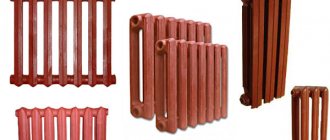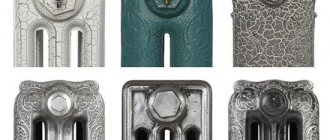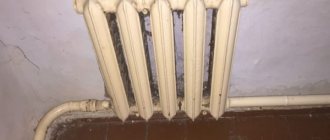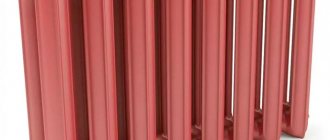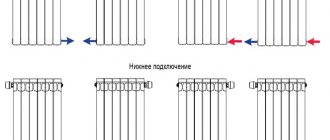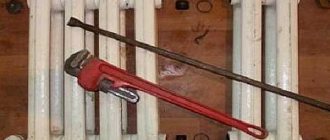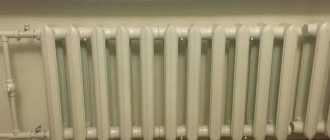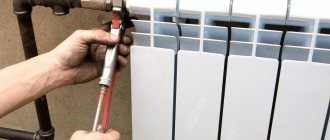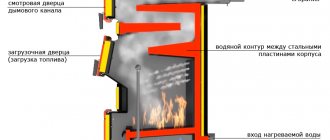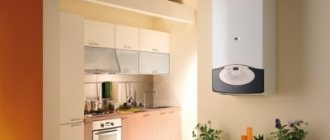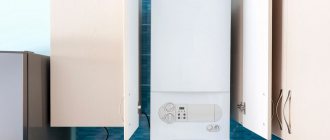Otherwise, some problems may occur during operation of the device. For example, the battery will not warm up evenly. Leaking may also occur. Most often, if the heating radiator does not warm up completely, the reason may be due to improper installation. Therefore, if you are not a specialist and are not confident in your knowledge and abilities, it is better to seek help from professionals. Conner heaters also occupy a leading place among the sales of heating devices on the market. They have good technical parameters. Therefore, there are only positive reviews of Konner cast iron heating radiators. Batteries from this manufacturer are affordable. They are produced in different configurations, with different diameters of inlet pipes and different numbers of sections.
You also need to ensure that the device is in good condition. Cast iron batteries are classic heating devices that have stood the test of time. Of course, today on the market manufacturers offer more modern types of radiators made from other metals. For example, bimetal, steel, aluminum. But still, cast iron batteries do not lose popularity. After all, cast iron heating radiators whose technical characteristics meet quality standards are distinguished by a number of significant advantages. The parameters and appearance of modern models of cast iron appliances have changed somewhat. Therefore, this article will focus specifically on the technical characteristics of this device.
Technical characteristics of cast iron radiators ms 140
At the moment, in our country, cast iron heating radiators MS 140 can be called the most common model of heating devices. These devices are manufactured in accordance with GOST 8690–94. Depending on the distance between the axes, there are five standard sizes of MS 140 batteries: 300, 400, 500, 600 and 800 mm. Previously, all standard sizes were used quite widely, and they could be seen not only in residential apartments, but also in administrative and industrial buildings . At the moment, the most commonly used cast iron radiators are MS 140 500 and 300. Other modifications are extremely rare and, as a rule, they are made to order.
In view of the popularity of ms 140 500 batteries, you should consider the technical parameters of this model. For heating cast iron radiators brand MS 140, the characteristics are given for one section, since this is a purely sectional model. By selecting the required number of sections, you can create an optimal temperature regime in the room. The main characteristics of heating radiators ms 140 500 are as follows:
- pressure. Working pressure is up to 9 atmospheres, and pressure testing is up to 15 atmospheres;
- heat transfer is low and equals 175 W;
- each section has two channels;
- section dimensions: height – 50 cm, width – 9.8 cm;
- the capacity of one section is 1.35 liters of water;
- The radiator is able to withstand coolant temperatures up to +130 degrees.
It is worth considering the design of a cast iron heating battery model ms 140 500. Gray cast iron is used for production. Nipples are made of malleable cast iron. Gaskets are installed between the sections. Heat-resistant rubber is used to produce gaskets.
The outside of the heater is covered with polymer enamel (usually white). Gaskets are EPDM rubber, the kit includes 4 end plugs. The cost of one KONNER Modern rib is 500 – 12 USD. That is, at least 4 pieces are sold. For rooms with low window sills, there is a series of low KONNER G1 batteries with an interaxial distance of 300 mm and a power of 120 W. When choosing radiators, we are guided by a standard algorithm. We determine the required thermal power, calculate the number of sections, and assemble heating devices for each room from them. Then - the purchase of heaters, installation kits and control valves.
The cost of one KONNER Modern rib is 500 12 USD.
Just 20 years ago, cast iron water heating radiators were found in almost every apartment, excluding high-rise buildings of 9...16 floors. Now they have given way to aluminum appliances, have changed and become a luxury item “thanks” to their exorbitant price. Although there are also inexpensive heater options on the heating equipment market. Having familiarized ourselves with the types and characteristics of modern cast iron batteries, we will list their real advantages and disadvantages.
- 1 Briefly about the design of batteries
- 2 Types of heating devices 2.1 Pros and cons of traditional “accordions”
- 2.2 Radiators with increased heat transfer area
- 2.3 Designer retro batteries
Characteristics and Features
The secret of their popularity is simple: in our country, the coolant in centralized heating networks is such that it even dissolves or erases metals. In addition to a huge amount of dissolved chemical elements, it contains sand, particles of rust that have fallen off pipes and radiators, “tears” from welding, bolts forgotten during repairs and a lot of other things that are unknown how they got inside. The only alloy that doesn’t care about all this is cast iron. Stainless steel also does this well, but one can only guess how much such a battery will cost.
MS-140 - an undying classic
And another secret of the MS-140’s popularity is its low price. It has significant differences between different manufacturers, but the approximate cost of one section is about $5 (retail).
Advantages and disadvantages of cast iron radiators
It is clear that a product that has not left the market for many decades has some unique properties. The advantages of cast iron batteries include:
- Low chemical activity, which ensures long service life in our networks. Officially, the warranty period is from 10 to 30 years, and the service life is 50 years or more.
- Low hydraulic resistance. Only radiators of this type can be installed in systems with natural circulation (some also use aluminum and steel tubular ones).
- High temperature of the working environment. No other radiator can withstand temperatures above +130oC. Most of them have a maximum limit of +110oC.
- Low price.
- High heat dissipation. For all other cast iron radiators, this characteristic is in the “disadvantages” section. Only MS-140 and MS-90 have a thermal power of one section comparable to aluminum and bimetallic ones. For MS-140, heat transfer is 160-185 W (depending on the manufacturer), for MS 90 - 130 W.
- They do not corrode when the coolant is drained.
MS-140 and MS-90 - difference in section depth
Some properties are a plus under some circumstances, and a minus under others:
- Large thermal inertia. It may take an hour or more until the MS-140 section warms up. And all this time the room does not heat up. But on the other hand, this is good if the heating is turned off, or a conventional solid fuel boiler is used in the system: the heat accumulated by the walls and water maintains the temperature in the room for a long time.
- Large cross-section of channels and collectors. On the one hand, even a bad and dirty coolant will not be able to clog them in just a few years. Therefore, cleaning and washing can be carried out periodically. But due to the large cross-section, more than a liter of coolant “fits” in one section. And it needs to be “driven” through the system and heated, which means extra costs for equipment (a more powerful pump and boiler) and fuel.
“Pure” disadvantages are also present:
- Heavy weight. The weight of one section with an axial distance of 500 mm is from 6 kg to 7.12 kg. And since you usually need from 6 to 14 pieces per room, you can calculate what the mass will be. And you will have to wear it, and also hang it on the wall. This is another drawback: difficult installation. And all because of the same weight.
- Fragility and low working pressure. Not the most pleasant characteristics. Despite their massive size, cast iron products must be handled with care: they may burst upon impact. The same fragility leads to not the highest operating pressure: 9 atm. Pressure testing - 15-16 atm.
- The need for regular coloring. All sections come only primed. They will need to be painted often: once every year or two.
Thermal inertia is not always a bad thing...
Application area
As you can see, there are more than serious advantages, but there are also disadvantages. If we summarize everything, we can determine the scope of their use:
- Networks with very low coolant quality (Ph above 9) and a large number of abrasive particles (without mud traps and filters).
- In individual heating when using solid fuel boilers without automation.
- In networks with natural circulation.
Types of heating devices
There is no official classification of cast iron batteries. We can roughly divide heaters into 3 types:
- Soviet-style “accordion” type MS-140;
- devices with an increased heat exchange area, simulating new bimetallic and aluminum heaters, only cast from cast iron;
- designer batteries made in retro, modern style.
Comment. Let us remind you: all cast iron heating devices are sectional, that is, stacked.
It is unrealistic to classify products based on other criteria. Technical characteristics - weight, dimensions, heat transfer - vary widely. Let's look at the properties of batteries by group.
Pros and cons of traditional accordions
To begin with, we present the technical parameters of one fin of the MS-140M radiator, taken from the technical data sheet:
- total height – 588 mm, between holes – 500 mm, depth – 14 cm (the number is included in the marking);
- heat flow (power) – 160 W, surface area – 0.21 m²;
- working pressure – no higher than 10 Bar;
- the volume of water inside the section is 1.45 liters, the maximum temperature is 130 °C;
- weight – 7.12 kg;
- material – gray cast iron SCh-10, plugs – malleable cast iron KCh-30 or steel;
- gaskets - rubber.
Dimensions of the MS-140 heater and recommended installation distances
Note. The amount of heat flow is indicated under certain operating conditions: the difference Δt between the temperature of the room air and the coolant is 70 degrees. The calculation of heat transfer of section 1 is described in a separate instruction. The letter "M" in the marking means "modernized".
“Accordions” are produced by several Russian enterprises and the Minsk Heating Equipment Plant. The average price for a MS-140M battery section is 10 USD. e., minimum – 6 cu. e.The mentioned Belarusian plant also produces modified versions of the “accordions”, shown in the photo below:
- lightweight model 2K60 with a power of 120 W, the fin weighs 5.1 kg;
- 2KP100-90-500 depth 9 cm, heat output - 140 W;
- modification BZ-140-300 with an interaxial distance of 30 cm, power - 120 W.
The undoubted advantages of radiators remain their affordable price, durability and corrosion resistance to chemically active substances. However, the latter advantage is inherent in all batteries made of cast iron.
- Soviet “accordions” of the MC type do not meet current interior design requirements. The new modifications look better.
- Fragility. A slight impact can cause a microcrack to form in the metal, and then a leak. Freezing of the coolant definitely leads to destruction; the expansion of water causes cast iron to split.
- Significant mass of the heating device, aggravated by spaciousness. Due to the coolant, each section is made heavier by 1-1.5 kg. The multi-section heater cannot be hung on a wall made of aerated concrete or a plasterboard partition, only placed on the floor.
- Limited scope. Due to the maximum operating pressure of 10 Bar, the radiator cannot be used in an apartment with central heating, where the water pressure reaches 12 Bar (at the time of testing the network).
- There is no bottom connection to the heating system, pipes are connected only from the side.
Inertia (long heating and cooling) cannot be attributed to the pros or cons of radiators. This is a feature of thick cast iron walls that does not affect the quality of heating.
Important note. The efficiency of the boiler and the efficiency of the system do not depend on the amount of water in the batteries. The load on the circulation pump is like fairy tales. If the volume of coolant is large, then only the time of initial heating and final cooling will change. Listen to the expert's opinion in the video:
It is worth mentioning one more advantage of the M-140 series batteries. Since “accordions” were previously used everywhere, working sections can be found for free or purchased from scrap metal. According to reviews from owners of private houses, used cast iron radiators are often used for heating outbuildings and utility rooms.
Radiators with increased heat transfer area
The uniformity of the shapes of cast iron appliances is due to the manufacturing technology - casting. The extrusion method used to produce aluminum sections is not applicable here. But in recent years the picture has improved - products with a flat front panel and side ribs, reminiscent of light alloy heaters, have appeared on the market.
Reference. The aluminum-look batteries shown in the photo are produced by Russian, Belarusian and Chinese companies: Konner, STI NOVA, Minsk Plant.
As an example, we list the characteristics of the KONNER Modern section with a standard center distance of 500 mm:
- total height – 60 cm, depth – 96 mm;
- heat transfer at Δt = 70 °C is 150 W;
- maximum water pressure in operating mode – 12 Bar;
- capacity – 0.9 liters;
- weight – 4.1 kg.
The outside of the heater is covered with polymer enamel (usually white). Gaskets are EPDM rubber, the kit includes 4 end plugs. The cost of one KONNER Modern rib is 500 – 12 USD. That is, at least 4 pieces are sold. For rooms with low window sills there is a series of low KONNER G1 batteries with a center distance of 300 mm and a power of 120 W.
Externally, Konner heaters are very similar to products made of aluminum alloy - the front section is flat, heat exchange fins are cast on the sides. Why are these batteries better than “accordions”:
- The heat transfer surface has increased thanks to the side fins and flat front panel.
- Accordingly, the share of infrared heating has increased. That is, the radiator began to transfer more heat through radiation.
- The depth of the fins has decreased without reducing heat transfer.
- The operating pressure is increased to 12 atmospheres.
The disadvantages of batteries are typical - the products are fragile and limited in coolant pressure. But we managed to solve the problem of appearance - now the heaters look no worse than bimetal. Prices have increased slightly - a section costs between 10...17 USD. e.
Note. The cost of a Belarusian radiator 2K60PP, equipped with a flat panel, is 21 USD. e. by the rib. The reason is the complication of the manufacturing process; mechanical processing of the frontal plane and painting were added.
Designer retro batteries
The selection of antique radiators is impressive in variety. In this case, technical parameters fade into the background, giving way to other characteristics:
- beauty;
- compliance with the design of the rooms;
- overall dimensions.
In addition to traditional two-channel devices, you can choose heaters with 3-4-5 channels. There are radiators with smooth surfaces and a relief pattern, designed for floor installation. Batteries in the Art Nouveau style have angular outlines, while retro ones are more rounded.
Explanation. Two-channel radiators have 2 vertical coolant flows, three-channel radiators have 3, and so on.
High-quality retro batteries are produced in the Czech Republic, Germany, Turkey, the Russian Federation, and more recently in China. Famous brands:
- Viadrus;
- Guratec;
- Demir Dokum;
- EXEMET;
- Retro Style;
- Iron Lion;
- taps and other retro-style fittings are produced by the Italian brand Carlo Poletti.
It is pointless to provide technical data for heaters, since the variation in power, dimensions and weight is too great. Prices also vary widely - from 20 to 250 USD. e. per section. Chinese and some Czech devices cost 20...30 USD. That is, Turkish and German are significantly more expensive. The cost greatly depends on the massiveness and design of the product.
The only parameter that remains unchanged is the operating pressure. In this regard, designer heating radiators are no better than “accordions”, since cast iron walls can withstand 15 Bar (maximum). The average value is 8…10 Bar. The table below shows the characteristics of several models:
| Radiator brand and model | A country | Weight, kg | Coolant volume, l | Thermal power, W | Price, y. e. |
| Viadrus KALOR 500/70 | Czech | 4 | 0.8 | 70.3 | 20.05 |
| Viadrus Bohemia 450/220 | Czech | 9.9 | 2.4 | 110 | 78.25 |
| Demir Dokum Nostalgia 500/200 | Türkiye | 9.6 | 2.3 | 163 | 52.20 |
| Retro Style Anerli 560/230 | Russia | 17 | 3.29 | 189 | 229.60 |
| EXEMET Modern 600/100 | Türkiye | 4.3 | 0.7 | 102 | 32 |
| EXEMET Classica 500/176 | Türkiye | 9.3 | 1.95 | 145 | 76.85 |
The negative and positive properties of retro heating devices in general repeat the advantages of previous varieties. The main difference is the high cost and massiveness of some batteries; the weight of 1 rib reaches 17...20 kg.
Transportation and storage The design of MS-90 cast iron radiators is ideally suited to Russian heating networks. They are unpretentious to the quality of the coolant, and allow the use of contaminated water, typical of central heating systems in Russia. MS-90 cast iron radiators are distinguished by their high thermal power and compact sectional design. Thick walls and the chemical properties of cast iron give radiators resistance to corrosion, which is important in the summer when the water from the heating system is drained and the radiator is left to rust “dry.” Due to its large mass, cast iron smoothes out temperature fluctuations.
Transportation and storage.
| 400 rub./section | from 210 sections |
| Basic | |
| Manufacturer country | Russia |
| Thermal power |
Technical characteristics of one section Operating conditions: operating pressure - 1.2 MPa (12 bar) test pressure - 1.5 MPa (15 bar) coolant temperature - up to 130 °C pH value - from 6.5 to 9 Product description Cast iron radiators have long established themselves as a simple and practical source of heating. Cast iron radiators MS-90 are reliable and time-tested heating devices, affordable and in no way inferior in quality! The design of MS-90 cast iron radiators is ideal for Russian heating networks. They are unpretentious to the quality of the coolant, and allow the use of contaminated water, typical of central heating systems in Russia. MS-90 cast iron radiators are distinguished by their high thermal power and compact sectional design. Thick walls and the chemical properties of cast iron give radiators resistance to corrosion, which is important in the summer when the water from the heating system is drained and the radiator is left to rust “dry.” Due to its large mass, cast iron smoothes out temperature fluctuations. Cast iron heating radiators MS-90 have been used effectively in our country for a long time. Cast iron radiators have become widespread due to their advantages: - high reliability and durability - wide range of applications - long useful life, more than fifty years - ease of maintenance and repair - if one or more sections fail, they can be replaced with new ones . Transportation and storage Transportation of radiators is permitted by any type of transport that ensures the safety of the devices from mechanical damage. Radiators are transported in bags. Package contents: 12 seven-section and 1 four-section radiator. Cast iron radiators should be stored indoors or under cover and protected from moisture and corrosive chemicals. The supplier is not responsible for transport damage to radiators. Warranty obligations Service life – up to 50 years. The manufacturer guarantees that radiators comply with the mandatory requirements of GOST 8690-94, provided that the consumer complies with the conditions of transportation, storage, installation and operation. If a defect is discovered due to the fault of the manufacturer during the warranty period, the radiator must be replaced by the organization that sold the device. Technical characteristics: Radiator type - sectional two-channel. Section length - 78 mm, height - 571 mm, depth -90 mm. Nominal heat flow - 0.130 kW. The capacity of one section is 1.15 l. Nipple hole thread: G 1/4-B. Radiators MS-90, unlike MS-140, have less weight, the weight of 1 section is 5.6 kg. for MS-140 -7.1-8kg. They are more compact, “thin” and can be easily hidden even under a small window sill. Their heat output is less than that of the MS-140, but due to less heat loss, the general characteristics are close to them.
The calculation of heating devices is carried out after the hydraulic calculation of the heating system pipelines using the following method. The required heat transfer of the heating device is determined by the formula: where is the temperature of the water in the hot main, °C;
If, during the renovation, a neighbor narrowed the hot water riser, installed a heated floor system, began heating a loggia or glassed-in balcony on which he built a winter garden, the pressure of hot water entering your radiators will, of course, decrease. This will depend on the type and quality of the material used in the manufacture of radiators. The main varieties include:
- made of cast iron;
- made of bimetal;
- made of aluminum;
- of steel.
Each of the materials has some disadvantages and a number of features, so to make a decision you will need to consider the main indicators in more detail.
Made from steel
They function perfectly in combination with an autonomous heating device, which is designed to heat a significant area. The choice of steel heating radiators is not considered an excellent option, since they are not able to withstand significant pressure. They are extremely resistant to corrosion, lightweight and heat transfer performance is quite satisfactory. Having an insignificant flow area, they rarely become clogged. But the working pressure is considered to be 7.5-8 kg/cm2, while the resistance to possible water hammer is only 13 kg/cm2. The heat transfer of the section is 150 W.
Made from bimetal
They do not have the disadvantages that are found in aluminum and cast iron products. The presence of a steel core is a characteristic feature, which made it possible to achieve colossal pressure resistance of 16 - 100 kg/cm2. The heat transfer of bimetallic radiators is 130 - 200 W, which is close to aluminum in terms of performance. They have a small cross-section, so over time there are no problems with contamination. Significant disadvantages include the prohibitively high cost of the products.
Made from aluminum
Such devices have many advantages. They have excellent external characteristics and do not require special care. They are strong enough, which means you don’t have to worry about water hammer, as is the case with cast iron products. The working pressure is considered to be 12 – 16 kg/cm2, depending on the model used. Features also include a flow area that is equal to or less than the diameter of the risers. This allows the coolant to circulate inside the device at tremendous speed, which makes it impossible for sediment to deposit on the surface of the material. Most people mistakenly believe that too small a cross-section will inevitably lead to low heat transfer rates. This opinion is erroneous, if only because the level of heat transfer from aluminum is much higher than, for example, that of cast iron. The cross section is compensated by the area of the fins. The heat output of aluminum radiators depends on various factors, including the model used, and can range from 137 to 210 W. Contrary to the characteristics given above, it is not recommended to use this type of equipment in apartments, since the products are not able to withstand sudden temperature changes and pressure surges inside the system (during the run of all devices). The material of an aluminum radiator deteriorates very quickly and cannot be subsequently restored, as is the case when using other materials.
Made from cast iron
The need for regular and very careful maintenance. A high rate of inertia is almost the main advantage of cast iron heating radiators. The level of heat transfer is also quite good. Such products do not heat up quickly, and they also give off heat for quite a long time. The heat output of one section of a cast iron radiator is equal to 80 - 160 W. But there are a lot of shortcomings here and the main ones are considered to be the following:
- Tangible weight of the structure.
- Almost complete lack of ability to resist water hammer (9 kg/cm2).
- There is a noticeable difference between the cross-section of the battery and the risers. This leads to slow circulation of the coolant and fairly rapid contamination.
Heat transfer from heating radiators in the table
Cast iron radiator MS-90-500 (heat output 0.135 kW/section)
Technical characteristics of one section
| Model | Dimensions in mm | Thread, G | Gross weight, kg | Volume, l | Heat dissipation Δt 70 °C, W | |||
| Center distance | Section height | Section depth | Section width | |||||
| 500/90 | 500 | 580 | 90 | 90 | 1 1/4 | 5,5 | 1,15 | 130 |
Terms of Use:
operating pressure – 1.2 MPa (12 bar) test pressure – 1.5 MPa (15 bar) coolant temperature – up to 130 °C pH value – from 6.5 to 9
Product description
Cast iron radiators have long established themselves as a simple and practical source of heating. Cast iron radiators MS-90 are reliable and time-tested heating devices, affordable and in no way inferior in quality!
The design of MS-90 cast iron radiators is ideal for Russian heating networks. They are unpretentious to the quality of the coolant, and allow the use of contaminated water, typical of central heating systems in Russia. MS-90 cast iron radiators are distinguished by their high thermal power and compact sectional design. Thick walls and the chemical properties of cast iron give radiators resistance to corrosion, which is important in the summer when the water from the heating system is drained and the radiator is left to rust “dry.” Due to its large mass, cast iron smoothes out temperature fluctuations.
Cast iron heating radiators MS-90 have been used effectively in our country for a long time. Cast iron radiators have become widespread due to their advantages: - high reliability and durability - wide range of applications - long useful life, more than fifty years - ease of maintenance and repair - if one or more sections fail, they can be replaced with new ones .
Transportation and storage
Transportation of radiators is permitted by any type of transport that ensures the safety of the devices from mechanical damage. Radiators are transported in bags. Package contents: 12 seven-section and 1 four-section radiator.
Cast iron radiators should be stored indoors or under cover and protected from moisture and corrosive chemicals.
The supplier is not responsible for transport damage to radiators.
Warranty
Service life – up to 50 years.
The manufacturer guarantees that radiators comply with the mandatory requirements of GOST 8690-94, provided that the consumer complies with the conditions of transportation, storage, installation and operation. If a defect is discovered due to the fault of the manufacturer during the warranty period, the radiator must be replaced by the organization that sold the device.
Specifications:
Radiator type: sectional two-channel. Section length - 78 mm, height - 571 mm, depth -90 mm. Nominal heat flow - 0.130 kW. The capacity of one section is 1.15 l. Nipple hole thread: G 1/4-B.
Radiators MS-90, unlike MS-140, have less weight, the weight of 1 section is 5.6 kg. for MS-140 -7.1-8kg. They are more compact, “thin” and can be easily hidden even under a small window sill. Their heat output is less than that of the MS-140, but due to less heat loss, the general characteristics are close to them.
General provisions and algorithm for thermal calculation of heating devices
The calculation of heating devices is carried out after the hydraulic calculation of the heating system pipelines using the following method. The required heat output of a heating device is determined by the formula: where is the heat loss of the room, W; when installing several heating devices in a room, the heat loss of the room is distributed equally between the devices; - useful heat transfer of heating pipelines, W; is determined by the formula: where is the specific heat transfer of 1 m of openly laid vertical/horizontal/ pipelines, W/m; is accepted according to the data in Table. 3 of Appendix 9, depending on the temperature difference between the pipeline and the air; - the total length of vertical / horizontal / pipelines in the room, m. Actual heat transfer of the heating device: where - the nominal heat flow of the heating device (one section), W. Accepted according to the data in the table. 1 of Appendix 9; - temperature pressure equal to the difference between half the sum of the coolant temperatures at the inlet and outlet of the heating device and the room air temperature: where - coolant flow through the heating device, kg/s; - empirical coefficients. The parameter values, depending on the type of heating devices, coolant flow rate and flow pattern, are given in Table. 2 Appendix 9;— correction factor, method of installing the device; is accepted according to the data in Table. 5 of Appendix 9. The average water temperature in a heating device of a single-pipe heating system is generally determined by the expression: where is the temperature of the water in the hot line, °C; is the cooling of water in the supply line, °C; is the correction factors taken according to the table. 4 and table. 7 of Appendix 9;— the sum of heat losses of the premises located before the room in question, counting along the direction of movement of water in the riser, W;— water flow in the riser, kg/s /determined at the stage of hydraulic calculation of the heating system/;— heat capacity of water equal to 4187 J /(kg deg);—the coefficient of water flow into the heating device. Accepted according to the table. 8 of Appendix 9. The coolant flow through the heating device is determined by the formula: The cooling of water in the supply line is found according to the approximate relationship: where is the length of the line from the individual heating point to the design riser, m. The actual heat transfer of the heating device must be no less than the required heat transfer, that is . The opposite relationship is allowed if the discrepancy does not exceed 5%.
The Hungarian company NAMI also produces high-quality products, although its quality is slightly inferior to that of Italian companies.
- weight of one section – 1…1.5 kg;
- capacity – 0.25…0.46 l;
- distance between axles – 20/35/50/80 cm;
- Guaranteed service life is 10...20 years.
Chinese appliances. In most European countries, they are abandoning the use of cast iron radiators in favor of aluminum or bimetallic ones, which have more compact dimensions, high efficiency and an attractive design. But they are characterized by two significant disadvantages:
- High price;
- Increased wear and tear due to poor quality coolant in the centralized system.
Therefore, for the CIS countries, heating devices made of cast iron are still relevant and in demand. They are characterized by:
- Long service life;
- Resistance to corrosion;
- Compliance with existing heating systems.
Plumbing in Petropavlovsk
Technical characteristics of one section
| Model | Dimensions in mm | Thread, G | Gross weight, kg | Volume, l | Heat dissipation Δt 70 °C, W | |||
| Center distance | Section height | Section depth | Section width | |||||
| 500/90 | 500 | 580 | 90 | 90 | 1 1/4 | 5,5 | 1,15 | 130 |
Terms of Use:
operating pressure - 1.2 MPa (12 bar) test pressure - 1.5 MPa (15 bar) coolant temperature - up to 130 °C pH value - from 6.5 to 9
Product description
Cast iron radiators
have long established themselves as a simple and practical source of heating. MS-90 cast iron radiators are reliable and time-tested heating devices, affordable and in no way inferior in quality!
The design of MS-90 cast iron radiators is ideal for Russian heating networks. They are unpretentious to the quality of the coolant, and allow the use of contaminated water, typical of central heating systems in Russia. MS-90 cast iron radiators are distinguished by their high thermal power and compact sectional design. Thick walls and the chemical properties of cast iron give radiators resistance to corrosion, which is important in the summer when the water from the heating system is drained and the radiator is left to rust “dry.” Due to its large mass, cast iron smoothes out temperature fluctuations.
Cast iron heating radiators MS-90
have been used effectively in our country for a long time. Cast iron radiators have become widespread due to their advantages: - high reliability and durability - wide scope of application - long useful life, more than fifty years - ease of maintenance and repair - if one or more sections fail, they can be replaced with new ones .
Transportation and storage
Transportation of radiators is permitted by any type of transport that ensures the safety of the devices from mechanical damage. Radiators are transported in bags. Package contents: 12 seven-section and 1 four-section radiator.
Cast iron radiators should be stored indoors or under cover and protected from moisture and corrosive chemicals.
The supplier is not responsible for transport damage to radiators.
Warranty
Service life - up to 50 years.
The manufacturer guarantees that radiators comply with the mandatory requirements of GOST 8690-94, provided that the consumer complies with the conditions of transportation, storage, installation and operation. If a defect is discovered due to the fault of the manufacturer during the warranty period, the radiator must be replaced by the organization that sold the device.
Table: heat transfer from heating radiators
Calculation for 1 (11 type), 2 (22 type), 3 (33 type) ribs
The heat output of the heating device must be at least 10% of the room area if the ceiling height is less than 3 m. If the ceiling is higher, then another 30% is added. In the room, the radiators are installed under the windows near the outer wall, as a result of which heat is distributed in the most optimal way. Cold air from the windows is blocked by the heat flow from the radiators going up, thereby eliminating the formation of drafts.
Heat transfer of one section according to the manufacturer's passport, W. The selection of a heating device based on the area of the room is a recommendation. The basis for selection was 100 W per 1 m2. According to SNiP, which clearly states that the thermal insulation of a room should be designed so that no more than 100 W of heat is lost per 1 m2. To accurately select the power of the heating device, it is necessary to calculate the heat loss through the building envelope, according to SNiP.
4 sections Du15 Qnu 424 W. Center distance, mmHeat transfer of one section according to the manufacturer's passport, WMaximum operating water pressure, bar
- 4 sections Du15 Qnu=424 W
- 7 sections DN15 Qnu=742 W
- 4 sections DN20 Qnu=424 W
- 7 sections DN20 Qnu=742 W
More.
- 4 sections Du15 Qnu=424 W
- 7 sections DN15 Qnu=742 W
- 4 sections DN20 Qnu=424 W
- 7 sections DN20 Qnu=742 W
Nominal heat flow in accordance with GOST 31311-2005 at dT = 70 oC Radiator length, mm Selection of a heating device according to the room area is a recommendation. The basis for selection was 100 W per 1 m2. According to SNiP, which clearly states that the thermal insulation of a room should be designed so that no more than 100 W of heat is lost per 1 m2. To accurately select the power of the heating device, it is necessary to calculate the heat loss through the enclosing structures, according to SNiP. When entering your personal account, after confirmation by the manager, individual prices for the client are activated on the website.
5. After completion of installation work, pressure testing of the entire water heating system is carried out, based on the results of which a certificate of commissioning of the facility is drawn up. This is done in a standard way - hydraulic tests are carried out under high pressure of 1.5 MPa, exceeding the maximum permitted loads. During the test, the prefabricated structure must not leak or allow air bubbles to pass through.
This is done in a standard way, hydraulic tests are carried out under high pressure of 1.5 MPa, exceeding the maximum permissible loads. The technical parameters of cast iron radiators of the MC 140 brand allow them to be used in steam heating systems of any buildings with virtually no restrictions: in private houses, country cottages, apartments in apartment buildings, administrative offices, public buildings, industrial, warehouse, and retail premises. The equipment is intended for operation in temperate and cold climates (MCC).
Advantages of heating radiators MS 140
- Long service life. This is one of the most durable types of radiators, with a service life of 50 years.
- Reliability. The hundred-year history of this type of radiator in the heating equipment market has confirmed in practice its high reliability.
- Anti-corrosion resistance. Cast iron does not deteriorate over time under the influence of water.
- Undemanding to the quality of the coolant. Cast iron radiators are not sensitive to the quality of the water used inside them. The presence of sand, dirt, high content of salts, acids, alkalis in water does not have a strong effect on the life of cast iron radiators.
- Simplicity of steam heating systems. Cast iron radiators can be used in networks with natural water circulation, without the use of a pump. They are compatible with all types of boilers - solid fuel, gas, pellet, liquid fuel.
- Thermal inertia. Cast iron takes a long time to heat up, accumulates heat well, and cools slowly. In a heating system, this is considered a great advantage, since after the burner is turned off, the cast iron radiator remains warm for a long time, releasing heat into the room.
Disadvantages of heating radiators MS 140
- Sensitivity to water hammer.
- Tendency to slagging of internal surfaces, which over time leads to a decrease in heat transfer.
- Radiators are assembled from separate sections, the joints of which are sealed with rubber gaskets. The lifespan of gaskets is significantly less than cast iron. To avoid leaks, after several years of operation, failed intersection gaskets must be replaced.
- The appearance of such radiators is not sophisticated enough; the surface requires painting.
Foreign cast iron radiators
Foreign-made cast iron batteries are made in modern or retro style. The latter have more weight due to inlay and artistic elements. As a rule, they can be installed on the floor.
Viadrus Termo (Czech Republic)
Without water
- 500/95 – 4.35;
- 500/130 – 5,35;
- 623/95 – 5,1;
- 623/130 – 6,45;
- 813/95 – 6,7;
- 813/130 – 8,8.
With water
- 500/95 – 4.95;
- 500/130 – 6,15;
- 623/95 – 5,9;
- 623/130 – 7,45;
- 813/95 – 7,7;
- 813/130 – 10,1.
Carron (England)
- The Chelsea 675/67 – 13.3;
- The Daisy – 11.3;
- The Orleans - 17.3;
- The Rococco – 16.6;
- The Verona – 14.3.
Carron Chelsea cast iron radiator.
Demrad Ridem (Türkiye)
- 2/813 – 5,15;
- 3/350 – 3,37;
- 3/500 – 4,8;
- 3/623 – 5,5;
- 3/813 – 7,05;
- 4/500 – 6,15;
- 4/623 – 7,25;
- 4/813 – 8,95.
Demrad Retro (Türkiye)
- 350/76 – 8,6;
- 500/76 – 11;
- 600/76 – 11,5;
- 800/76 – 13,5.
Cast iron radiator Demrad Retro.
When taking into account the mass of a cast iron radiator, you should not forget about additional loads - taps, plugs, pipes. If the battery is located far from the riser, the weight of the water pipe can place a significant additional load.
Do you want to get help from a master, a specialist in this field? Go to the professional search portal. This is a completely free service where you will find a professional who will solve your problem. You do not pay for posting an ad, views, or choosing a contractor. If you are a master of your craft, then register on Pro and receive a flow of clients. Your profit is just one click away!
Technical characteristics of radiators MS-140 - 500
Radiators of the MC group belong to the category of sectional - they are assembled into a single whole from individual sections. MS 140 cast iron radiator section. The sections are connected into a radiator using intersectional gaskets.
Intersectional gasket for cast iron radiator MS 140. One section is pressed against the other using a nipple.
Nipple of a cast iron radiator ms 140. The ends of the radiator are closed with plugs, which can be shut-off or straight-through.
Radiator shut-off plug ms 140.
Radiator passage plug ms 140. Sections are cast from gray cast iron with graphite additives. Individual parameters of MC 140 radiators may vary slightly in models from different manufacturers. Main characteristics of the cast iron radiator model MC 140:
| Radiator type | sectional |
| Number of coolant channels, pcs. | 2 |
| Number of sections, pcs | from 2 to 10 |
| Nominal heat flow of one section, W | 160 |
| External casing coating | primer GF-021/0119 |
| Section material | gray cast iron in accordance with GOST 1412-85 |
| Intersectional gasket material | rubber according to GOST 1412, capable of withstanding temperatures up to +150ºC |
| Nipple material | cast iron or steel. GOST 1412 or 1050 |
| Heating area of one section, m2 | 0.195 |
| Center distance, mm | 500 |
| Nipple hole thread size | G11/4 |
| Type of coolant | water |
| Maximum coolant temperature, 0C | + 1300С |
| Operating excess coolant pressure, MPa (kgf/cm2) | 0.9 |
Other technical data:
| Number of sections, pcs. | Weight, kg | Length, mm | Nominal heat flow, kW | Capacity, dm3 (l) |
| 2 | 12.8 | 227 | 0.32 | 2.50 |
| 3 | 18.8 | 331 | 0.48 | 3.75 |
| 4 | 24.8 | 435 | 0.64 | 5.00 |
| 5 | 30.8 | 539 | 0.80 | 6.25 |
| 6 | 36.8 | 643 | 0.96 | 7.50 |
| 7 | 42.8 | 747 | 1.12 | 8.75 |
The basic characteristics of the radiator can be determined by the model name and markings. For example , model MC-140-500-0.9-7 designates a radiator with the name MC, depth 140 mm, center distance 500 mm, maximum pressure in the system 0.9 MPa, with the number of individual blocks in the radiator equal to 7.
MS-140 - cast iron classic of “Soviet” times
Cast iron heating radiators MC 140 can be called an undying classic. Despite the abundance of different models of heating devices made of the same cast iron, this one - a Soviet-era “accordion” - is still in demand. It is produced in most countries that were formerly part of the USSR. They are precisely produced in Russia, Ukraine and Belarus. Perhaps production has been established in other countries, but why transport goods far away if there are factories nearby.
Characteristics and Features
The secret of their popularity is simple: in our country, the coolant in centralized heating networks is such that it even dissolves or erases metals. In addition to a huge amount of dissolved chemical elements, it contains sand, particles of rust that have fallen off pipes and radiators, “tears” from welding, bolts forgotten during repairs and a lot of other things that are unknown how they got inside. The only alloy that doesn’t care about all this is cast iron. Stainless steel also does this well, but one can only guess how much such a battery will cost.
MS-140 - an undying classic
And another secret of the MS-140’s popularity is its low price. It has significant differences between different manufacturers, but the approximate cost of one section is about $5 (retail).
Advantages and disadvantages of cast iron radiators
It is clear that a product that has not left the market for many decades has some unique properties. The advantages of cast iron batteries include:
- Low chemical activity, which ensures long service life in our networks. Officially, the warranty period is from 10 to 30 years, and the service life is 50 years or more.
- Low hydraulic resistance. Only radiators of this type can be installed in systems with natural circulation (some also use aluminum and steel tubular ones).
- High temperature of the working environment. No other radiator can withstand temperatures above +130oC. Most of them have a maximum limit of +110oC.
- Low price.
- High heat dissipation. For all other cast iron radiators, this characteristic is in the “disadvantages” section. Only MS-140 and MS-90 have a thermal power of one section comparable to aluminum and bimetallic ones. For MS-140, heat transfer is 160-185 W (depending on the manufacturer), for MS 90 - 130 W.
- They do not corrode when the coolant is drained.MS-140 and MS-90 - difference in section depth
Some properties are a plus under some circumstances, and a minus under others:
- Large thermal inertia. It may take an hour or more until the MS-140 section warms up. And all this time the room does not heat up. But on the other hand, this is good if the heating is turned off, or a conventional solid fuel boiler is used in the system: the heat accumulated by the walls and water maintains the temperature in the room for a long time.
- Large cross-section of channels and collectors. On the one hand, even a bad and dirty coolant will not be able to clog them in just a few years. Therefore, cleaning and washing can be carried out periodically. But due to the large cross-section, more than a liter of coolant “fits” in one section. And it needs to be “driven” through the system and heated, which means extra costs for equipment (a more powerful pump and boiler) and fuel.
“Pure” disadvantages are also present:
- Heavy weight. The weight of one section with an axial distance of 500 mm is from 6 kg to 7.12 kg. And since you usually need from 6 to 14 pieces per room, you can calculate what the mass will be. And you will have to wear it, and also hang it on the wall. This is another drawback: difficult installation. And all because of the same weight.
- Fragility and low working pressure. Not the most pleasant characteristics. Despite their massive size, cast iron products must be handled with care: they may burst upon impact. The same fragility leads to not the highest operating pressure: 9 atm. Pressure testing - 15-16 atm.
- The need for regular coloring. All sections come only primed. They will need to be painted often: once every year or two. Thermal inertia is not always a bad thing...
Application area
As you can see, there are more than serious advantages, but there are also disadvantages. If we summarize everything, we can determine the scope of their use:
- Networks with very low coolant quality (Ph above 9) and a large number of abrasive particles (without mud traps and filters).
- In individual heating when using solid fuel boilers without automation.
- In networks with natural circulation.
Manufacturers, models, technical specifications
MS-140 is produced by the following factories:
- Nizhny Tagil Boiler and Radiator Plant (Russia);
- Minsk Heating Equipment Plant (Belarus);
- Lugansk Foundry and Mechanical Plant (Ukraine);
- JSC "Santekhlit" Bryansk region (Russia);
- LLC "Descartes" Novosibirsk (Russia).
The product has some features and differences; there are models with center distances of 300 mm and 500 mm, as well as a smaller depth option MS-90.
Nizhny Tagil Boiler and Radiator Plant
The plant's products are certified according to the ISO 9001:2008 standard in the Russian Register certification, there is a certificate from the GOST R System and IQNet.
Overall dimensions of MS-140 produced in Nizhny Tagil
Coolant temperature up to +130 oC, operating pressure up to 12 Bar, other technical characteristics are given in the table.
| Model name | Center distance | Dimensions | Section thermal power | Section volume | Section weight | ||
| width | depth | height | |||||
| MS-140-M2-500 | 500 mm | 94 mm | 140 mm | 580 mm | 160 W | 1.45 l | 6.65 kg |
| MS-140M-300 | 300 mm | 104 mm | 140 mm | 388 mm | 117 W | 1.11 l | 5.4 kg |
| MS-90 | 500 mm | 90 mm | 90 mm | 580 mm | 130 W | 1.15 l | 5.475 kg |
Appearance and dimensions of MC-90
Minsk Heating Equipment Plant
The company produces cast iron radiators MS-140 only with a center distance of 500 mm, but there is also a modified three-channel BZ-140-300, and it is also possible to install them on legs rather than hanging them on the wall.
